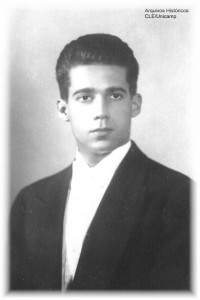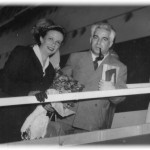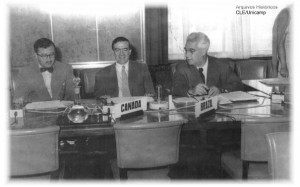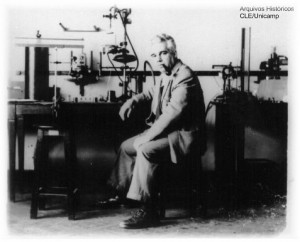
Graduated as a civil engineer and mechanical electrician engineer in 1928 by the Brazilian National School of Engineering, Costa Ribeiro became a lecturer at the newly founded University of Brazil (today UFRJ) and became part of the National Institute of Technology, which had a better laboratory infrastructure than the university. Thus, Costa Ribeiro participated in two of the very few institutions devoted to teaching and research in science existing in Brazil at the time.
Since 1943, Costa Ribeiro worked with German physicist Bernard Gross, who arrived in Brazil in 1933 and organized the first physics course in Rio de Janeiro two years later. Costa Ribeiro and Gross, giants of Brazilian science, can be considered the national pioneers of condensed matter physics, discipline that is among the pillars of the materials field. By the time they developed their studies, research in Physics in Brazil focused on the Nuclear and Particle fields, developed by scientists such as Cesar Lattes, Mário Schenberg and Jayme Tiomno.
Initially, Costa Ribeiro studied new methods for measuring radioactivity and applying them to Brazilian minerals, achieving notable contributions. Then, he began studying dielectric materials (solid electrical insulators), such as naphthalene and carnauba wax (typical palm tree from Northeastern Brazil), and electrets (solids with quasi-permanent electric charge).
It was then that Costa Ribeiro first observed an interesting effect while working with some dielectric materials. Fusion by heating without the application of external electric fields, caused an electric current to appear in the insulating material. Once solidified, the samples remained charged, constituting electrets. In conclusion, all it took for forming the electret, was the natural solidification of dielectric material after being melted by heating. According to Bernard Gross´s memory, recovered in an article by Professor Guilherme Leal Ferreira , this first experiment was performed with carnauba wax.
The elucidation of the phenomenon
In an interview of the Historical Archives of CLE/Unicamp, held in 1988, scientists Jayme Tiomno and Elisa Frota Pessoa, who were Costa Ribeiro´s students and his aides in the thermal-dielectric effect, shared their memories about the process that led to the elucidation of the phenomenon. According to them, in 1943, Costa Ribeiro decided to take the examination for the position of Professor in the University of Brazil, for which he had to prepare a thesis with original research. The professor then took the suggestion of Bernard Gross and studied pure organic electrets.
“He started by repeating the preparation of the electret using naphthalene and observing its properties. (…) He worked intensely, usually in the afternoons and evenings. One night, after putting the molten naphthalene in a cell to solidify and apply the electric field, he had to stop and leave. On the next day, he removed the naphthalene solid disc to melt and restart, but he decided to examine it using the electrometer. It was an electret!”
Yet, this was not the thermo-dielectric effect, but a static effect, according to Tiomno, who described: “After preparing several electrets without the application of an external electric field, he realized that the effect was stronger when cooling was faster – it was an effect of solidification rate. He, then, built an ingenious and very-well finished apparatus with which he could observe the movement of the liquid naphthalene interface with that solidified by cooling, simultaneously measuring the solidification rate (or melting) and the intensity of the electric current detected in a Wulf electrometer. Upon the verification of the correlation of these quantities, the thermo-dielectric phenomenon or Costa Ribeiro effect was discovered.
- Costa Ribeiro in his lab, 1952. Source: Acervo Costa Ribeiro/ Arquivos Históricos em História da Ciência/CLE-Unicamp.
Dissemination of the research
Ribeiro´s first publication describing the effect is dated 1943. Entitled “Sobre a eletrização da cera de carnaúba na ausência de campo elétrico exterior“, the communication was made in the form of a presentation to the Brazilian Academy of Science and then, in an article published in the records of the institution. In 1945, the thermo-dielectric effect was subject of a thesis presented by Costa Ribeiro to the National Faculty of Philosophy of the University of Brazil in the examination for a position of Professor of General and Experimental Physics. In 1953, the Brazilian Academy of Science awarded him the Einstein Award for the thermo-dielectric effect.
In the interview to CLE/Unicamp, Jayme Tiomno and Elisa Pessoa also talked about the dissemination of the effect abroad. According to them, it began by Costa Ribeiro in Argentina, in meetings of the Argentinian Physics Association in 1945 and 1948. Also in 1948, invited by the University of Paris, Costa Ribeiro conducted three lectures at Sorbonne. In 1951, a summary of his work, which had been published in English in the Records of the Brazilian Academy of Science, was indexed in the “Physics Abstracts”. In 1954, the scientist held four lectures on his research, in the United States, at the Massachusetts Institute of Technology, in the Bureau of Standards (current National Institute of Standards and Technology), at Yale University and at General Electric.
In May 1950, US scientists Everly J. Workman and Steve E. Reynolds published a paper in Physical Review describing the same phenomenon, observed by them in the phase transition between water and ice. Consequently, the phenomenon of electrification of insulating materials in such change phase is reported in literature under various names, sometimes “Costa Ribeiro effect”, sometimes “Workman-Reynolds effect” or, simply “thermo-dielectric effect.”
The article by Professor Leal Ferreira on the Costa Ribeiro effect states that it is known today that the phenomenon of electrification of dielectrics generated by their solidification had been mentioned in the eighteenth century by Stephen Gray, one of the pioneers of experimental studies on electrical conduction. Ferreira highlights in his article that much beyond the merit of priority of discovery, there is Joaquim Costa Ribeiro´s merit of persistence in experimentally studying the effect found – merit increased by the precarious conditions of work at the time in Brazil.
Despite having a tendency of “getting by” alone, from the construction of his laboratory tools to the interpretation of results, Costa Ribeiro had collaborators in his studies on thermo-dielectric effect. Tiomno, for instance, contributed greatly to the theoretical part, up to a point where he was given a special thanks from the Professor in the thesis presented to the University of Brazil. Armando Dias Tavares and Sergio Mascarenhas were also collaborators and followers of research on the topic.
Regarding the effect applications, Mascarenhas says that the phenomenon has more fundamental than applied science value, although there are some applications, as described in a 1968 article about its use in aeronautical sector radiometers (L.D. Russel and B.H. Beam, Journal of Spacecraft and Rockets, vol. 5, pg. 1501, 1968). “Unfortunately, the effect is little taught in traditional courses,” laments Mascarenhas.

More about Joaquim Costa Ribeiro
Married to a French woman, to whom he dedicated many of his poems, Costa Ribeiro was the father of eight children. In order to support his family, at a time when university professors earned a few minimum wages, the scientist had multiple concurrent jobs. He taught at several institutions and schools.
Co-workers and relatives describe him with adjectives like: humanistic, serene, humble, resourceful, self-educated, handy, intuitive, intelligent and thorough.
Very catholic, questioned by his students on how to reconcile religion and science, he said: “It’s simple, I completely separate them. When I am in religion, I am in religion; when I am in science, I am in science”.
In addition to his scientific contributions, Costa Ribeiro played important roles in creating the Brazilian Center for Physical Research, CBPF, (1949) and the Brazilian Federal Council for Scientific and Technological Developmente, CNPq, (1951). He also participated in several national and international initiatives on the use of nuclear energy.
He died in 1960 in Rio de Janeiro.



Richard
Bom conhecer mais sobre nossos gênios brasileiros.